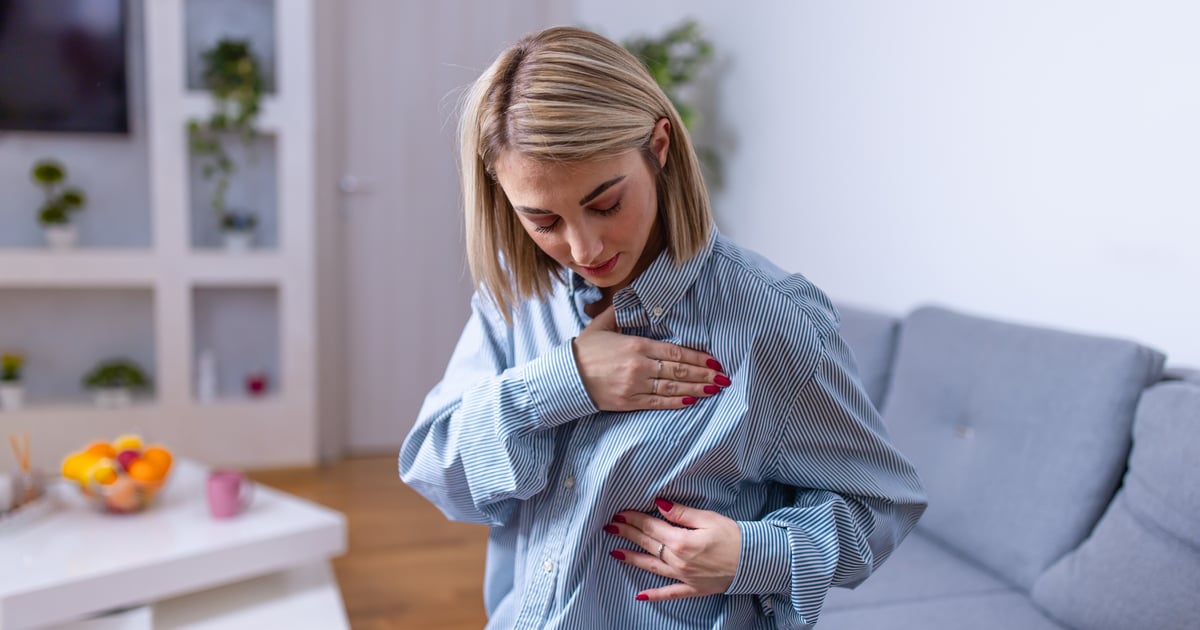
When it comes to your boobs, you may or may not give them much thought. But when something is off with them, like a pain under your left breast, it’s hard not to jump to the worst-case scenario.
“Pain under the left breast can be caused by various reasons, including issues with or related to the breast, or from another cause entirely like heart, lung, skin, muscle, or digestive issues,” says Amy Wetter, MD, a board-certified ob-gyn at Pediatrix Medical Group in Atlanta, Georgia. In fact, pain is more common on the left side because the heart, stomach, colon, spleen, and pancreas are located in the upper left region of your body, she adds.
Sometimes the pain is direct and visible, due to a rash or direct injury, while other times the causes are less obvious and occurring internally, says Alexandra Kharazi, MD, a board-certified cardiothoracic surgeon and author of “The Heart of Fear”. In terms of what it feels like, pain under your left breast can be dull, achy, throbbing, fleeting, burning, or sudden and sharp, depending on the cause, she adds.
To help you find out what you’re dealing with, here’s a starting point for what pain under the left breast may mean. Ahead, doctors weigh in on the 12 most common causes of pain under the left breast.
Why Do You Have Left Breast Pain?
Pain under your left breast can be a scary symptom, triggering thoughts of severe illness, but it’s not always a red flag or cause for concern. The accompanying symptoms can tell you a lot about what’s causing the pain and when to see a doctor. Read on to understand more of what’s causing your discomfort.
Breast injury
Yep, it is possible to injure your breast and the surrounding muscle, Dr. Wetter says. This may be caused by a trauma such as falling or a car accident, or something more subtle like exercising or playing a contact sport, she explains. You may have bruising or swelling, and it might be tender to the touch, but this pain usually subsides with time and over-the-counter painkillers like Advil, Tylenol, or Aleve, she adds.
If your discomfort doesn’t dissipate after a few weeks, check in with your doctor. And if your pain is extreme or you recently were in an accident, it’s best to get checked by a physician ASAP in case you also damaged your heart or spleen, Dr. Kharazi adds.
Breast Infection
A breast infection is possible and would likely cause pain, redness, pus, and a foul odor, Dr. Kharazi says. Breast infection is common among women who breastfeed and in these cases is often referred to as lactational mastitis, per Johns Hopkins Medicine. Lactational mastitis can happen when bacteria from the baby’s mouth enters the ducts and rapidly multiplies in the milk or when the milk duct becomes blocked. Treatment typically involves trying to unblock the duct via warm compresses or a massage. You doctor may also provide antibiotics and pain medication. “In some cases, lactational mastitis progresses and forms a pus-filled infection (abscess). This is a more serious condition that may require drainage,” Johns Hopkins Medicine states.
Outside of breastfeeding, breast infections can also happen “in those with obesity and diabetes, but also in those who are immunosuppressed,” Dr. Kharazi explains. In these instances, it is referred to as nonlactational mastitis. The condition is rare, but treatment often consists of antibiotics.
When it comes to breast infections, it’s generally best to see your doctor sooner rather than later to ensure that abscesses do not form and grow, Dr. Kharazi adds.
Hormones
If you have breast pain or tenderness before, after, or during your menstrual cycle, it’s likely caused by hormones, Dr. Wetter says. Oral contraceptives, hormone replacement therapy, and infertility medicines can also cause hormonal breast pain, she adds. This type of pain typically resolves with a change in your cycle or by taking over-the-counter painkillers, according to Dr. Wetter, but talk with your doc if the irritation worsens.
Lung Infection
Lung infections are known to cause breast pain and are associated with fever, cough, shortness of breath, and low energy or fatigue, Dr. Kharazi says. “Treatment for infection consists of antibiotics as a mainstay, but it can include chest tubes or even chest surgery if the infection has progressed to empyema (a cavity of pus between the lung and chest wall),” she explains. Any of those symptoms warrant a conversation with a healthcare provider, so if you notice symptoms, schedule a visit with your doctor, she adds.
Poorly Fitted Bra
If your bra is from the seventh grade, it may be the culprit of your pain, Dr. Wetter says. You’ll likely have discomfort or soreness especially in the area of the underwire and changing to a better fitting bra will help, she adds.
Another tip? If your pain gets better every time you remove your bra, it might be time for a new one, Dr. Kharazi says.
Gastroesophageal Reflux Disease
Gastroesophageal reflux disease, also known as GERD, is a common cause of chest or pain in the breast area. It is usually accompanied by a burning sensation while lying down or after eating and a bitter or sour taste in your mouth, Dr. Wetter says. This occurs when stomach acid repeatedly flows back into the tube connecting your mouth and stomach, per the Mayo Clinic. You may be able to manage symptoms with OTC antacids, but if your pain interferes with daily activities, it’s time to see a doctor, Dr. Wetter adds.
Lung Cancer
A more serious cause of pain under your left breast could be lung cancer, Dr. Kharazi says. It may also be accompanied by progressive shortness of breath, fatigue, a general feeling of discomfort, and severe muscle loss, she explains. “If you have those symptoms, seek care immediately, particularly if you have risk factors for lung cancer, the biggest one being smoking,” she adds.
A diagnosis of lung cancer typically entails a chest scan and biopsy, and treatment depends on the stage but may consist of surgery, radiation, and/or chemotherapy, Dr. Kharazi says.
Shingles
Shingles is a painful, very itchy rash that typically develops on one side of the face or body and can cause breast pain, Dr. Wetter says. The rash is also followed by headache, chills, or an upset stomach, according to the Centers for Disease Control and Prevention (CDC). A vaccine is recommended and available to prevent shingles and the related complications, but treatment consists of antiviral medications, Dr. Wetter adds. If you notice a rash and the above symptoms, visit your doctor.
Heart Attack
If you have chest pain or pressure, shortness of breath, pain in your neck or jaw, dizziness, anxiety, sweating, nausea, and/or vomiting, it may be a heart attack and you need to call 911 immediately, Dr. Wetter says.
A heart attack occurs when the flow of blood to the heart is severely reduced or blocked, usually due to a buildup of fat or cholesterol, per the Mayo Clinic. Some heart attacks happen suddenly, but the Mayo Clinic shows many people have warning signs and symptoms hours, days, or weeks in advance. If you notice symptoms, call 911 or see a doctor ASAP.
Costochondritis
Costochondritis is caused by inflammation between the ribs and sternum, Dr. Kharazi says. It often worsens with motion or deep breathing, and you typically feel a sharp pain on the left side beneath your breast, she adds. There is usually no clear cause, but it may result from trauma, illness, or physical strain from severe coughing, per the Mayo Clinic.
Treatment typically consists of rest, topical heat or ice packs, over-the-counter painkillers, and avoiding activities that cause discomfort, Dr. Kharazi adds. Costochondritis usually resolves on its own, but if pain worsens or persists for more than a week, visit your doctor.
Breast Cancer
If you feel a lump or mass under your breast, along with pain, it’s best to schedule a visit with your doctor to rule out breast cancer, Dr. Wetter says. From there, they will examine the area and perform a breast ultrasound or mammogram, she explains. Other symptoms may include skin irritation and redness over the breast, peeling around the nipple, or swelling of all or part of the breast, according to the Mayo Clinic. To detect early signs of breast cancer, talk with your doctor about regular cancer screenings and yearly mammograms.
Heart Disease
Heart disease describes a range of conditions that affect the heart, but it’s typically associated with coronary blockages, or blockages in the arteries supplying the heart muscle, Dr. Kharazi says. “This can manifest as left breast pain, although the issue is the heart itself, and if someone has risk factors for coronary disease such as high blood pressure, high cholesterol, smoking, diabetes, obesity, or a family history [of heart disease], this pain should trigger a cardiac workup,” she explains. Additional symptoms include chest pain or discomfort, dizziness, fluttering in the chest, lightheadedness, and shortness of breath, per the Mayo Clinic.
If you’re diagnosed with heart disease, the treatment varies based on the type of disease and can include valve replacement, bypass grafting, or stenting, Dr. Kharazi adds.
The Bottom Line
Pain under your left breast (or any type of breast pain) can be scary and uncomfortable, but don’t automatically assume the worst. “If you are unsure if your breast pain is a cause of concern, it’s best to run it by a healthcare provider who can more accurately assess your specific symptoms and risk factors and point you in the right direction,” Dr. Kharazi says.
If your breast pain is associated with shortness of breath, pain in your neck or jaw, dizziness, anxiety, sweating, nausea, and/or vomiting, seek help immediately as it may be a sign of a heart attack, Dr. Wetter adds. Additionally, if you have a breast mass, redness, or worsening pain that lasts longer than a week, Dr. Wetter recommends visiting your doctor for an exam.

